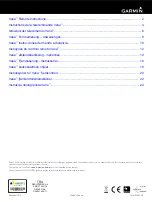
ALM
®
12V7 s-Series User’s Guide
Chapter 2: Regulatory Compliance
406014-02EN, Rev. 05
© 2016 NEC Energy Solutions, Inc. All rights reserved.
Page 13 of 49
This document contains the proprietary information of NEC Energy Solutions, Inc. (“NECES”) and may not be modified,
reproduced, retransmitted or redistributed, either in whole or in part, for any reason without NECES’ prior written consent.
integrator must verify that the ALM 12V7 s-Series-powered host product is compliant with all
applicable regulations. Refer to
on page 14 for a list of proper names and UN
numbers required for shipping lithium-ion batteries.
Regulations Overview
Rechargeable lithium-ion (including lithium-ion polymer) cells and batteries are considered
dangerous goods. The regulations that govern their transport are based on the UN
Recommendations on the Transport of Dangerous Goods Model Regulations. Transport of
dangerous goods is regulated internationally by:
•
International Civil Aviation Organization (ICAO) Technical Instructions
•
International Air Transport Association (IATA) Dangerous Goods Regulations
•
International Maritime Dangerous Goods (IMDG) Code
In the United States, transportation of hazardous material is regulated by Title (part) 49 of the
Code of Federal Regulations or CFR’s. Title 49 CFR Sections 100-185 of the U.S. Hazardous
Materials Regulations (HMR) contains the requirements for transporting cells and batteries.
Refer to the following sections within 49 CFR for specific information.
•
Section 173.185 – Shipping requirements for lithium cells and batteries
•
Section 172.102 – Special Provisions
•
Sections 172.101, 178 – Further information and specifications on packaging
The Office of Pipeline and Hazardous Materials Safety Administration (PHMSA), which is
within the U.S. Department of Transportation (DOT), is responsible for drafting and writing the
U.S. regulations that govern the transportation of hazardous materials (also known as
dangerous goods) by air, ground, and ocean.
Regulations by Cell/Battery Size
Lithium-ion batteries and cells are considered Class 9, which is one of nine classes of
hazardous materials or dangerous goods defined in the regulations. As a class 9 material,
cells and batteries must meet UN testing and packaging requirements as well as shipping
regulations.
Following International and U.S. DOT Regulations
Failure to comply with International and U.S. DOT regulations while transporting Class 9
Hazardous Materials (Dangerous Goods) may result in substantial civil and criminal penalties.














































